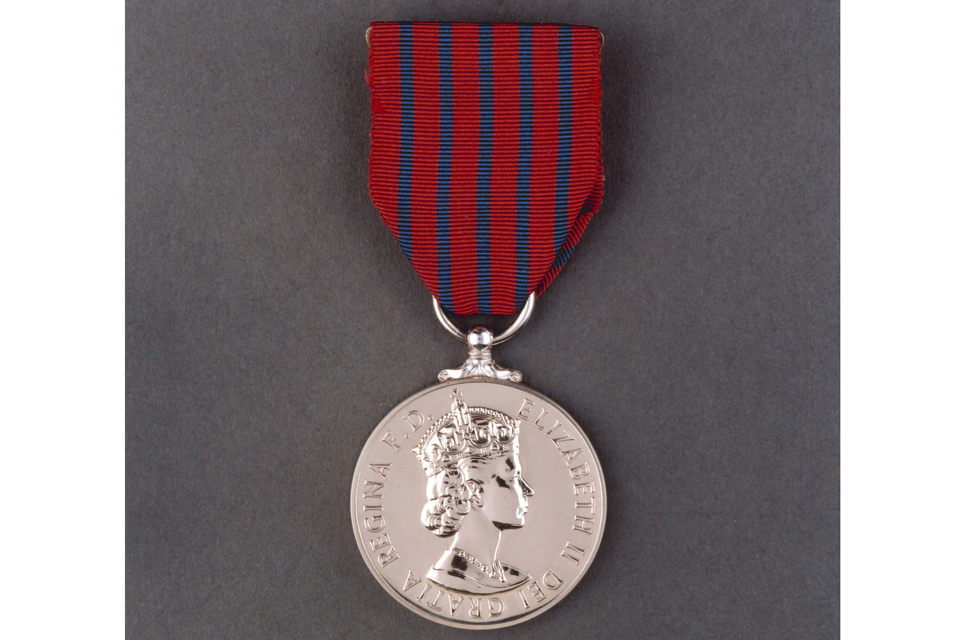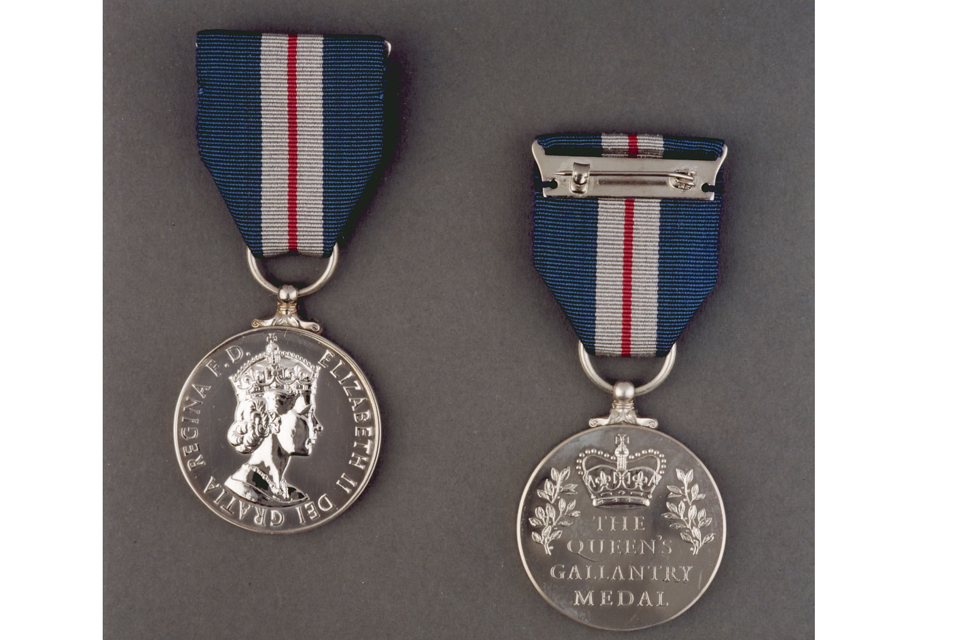Civilian Gallantry List: 2017
This lists the names of people who have received The George Medal, The Queen's Gallantry Medal and The Queen's Commendation for Bravery.

Queen's Commendation for Bravery Medals
Her Majesty The Queen has been graciously pleased to approve the following awards of The George Medal and The Queen’s Gallantry Medal and for publication in The London Gazette of the names of those shown below as having received an expression of Commendation for Bravery.
George Medal

George Medal
Martin Finney, National Crime Agency, for tackling an armed assailant
Martin Finney is a member of a team of investigators and surveillance officers. In May 2014, he was on a surveillance operation in Tottenham, London in relation to the activities of an organised crime group who had a history of witness intimidation, threats and targeted shootings. At about 22:45, the team was ‘stood down’ and Martin Finney began walking back to his vehicle. As he did so, he noticed a male who was hooded and wearing gloves. As the male approached some premises, he drew a handgun and fired 3 shots into the doorway of a bar/pool club, which contained 20 to 30 people. Martin Finney ran towards the suspect and issued a challenge and drew his pistol. At this point, Martin Finney was alone and with no communication with the rest of his team.
The male turned and ran towards Martin Finney and fired at him, the shot passing within a few centimetres. Martin Finney returned fire with a single shot at the suspect. The shot missed and the suspect continued his escape, then stopped and fired back a further 3 times. Despite the danger, Martin Finney pursued the suspect into a dark residential street in a high crime area, with no support. He returned fire with a second single shot. The suspect responded by firing again at Martin Finney, who continued verbally to challenge the suspect and advanced across the street to him. The suspect responded by raising his arms and putting down his weapon. It transpired that he had fired all the bullets in his weapon. Martin Finney reacted with outstanding bravery to pursue and apprehend a dangerous criminal, at significant risk to his own life. The offender had discharged his weapon on a number of occasions and Martin Finney was under the impression that he may have wounded or even killed members of the public. He continued to pursue the offender despite continued shots being fired directly at him. He had no body armour and was covertly deployed in plain clothes. The suspect was convicted and sentenced to 15 years’ imprisonment.
Queen’s Gallantry Medal

Queen's Award for Gallantry Medal
PC Nathan Lucy, Hampshire Constabulary, for saving a woman from drowning
On 12 April 2014 PC Lucy was on duty when he was made aware of a female who had walked out of a mental health hospital after attending as a voluntary patient. The woman had made numerous threats to her own safety.
PC Lucy responded to a radio message stating that the same woman had jumped into the water from the Red Jet Terminal in Cowes. The officer saw the woman in the water and knew that she was being swept out by the current. He ran to 3 different locations to get ahead of her in the water and shouted at her to swim towards him, but she ignored him. PC Lucy considered the woman to be in danger of drowning due to the current and temperatures known to make that stretch of water dangerous. He therefore took a life ring and jumped into the sea and started to swim towards the woman. When he reached her, he stretched out towards her but she kicked him in the chest. He eventually managed to get hold of the female but she pushed him under the water.
When he resurfaced, this time he successfully pulled her towards him and gripped the life ring. Someone on the jetty then started to pull them in. The woman continued to resist but then went very still with her eyes closed. PC Lucy pushed her head higher out of the water which again caused him to go under. Despite this he retained hold of her until they were finally pulled into the jetty where she was lifted out and given immediate life saving treatment before being conveyed to hospital.
PC Lucy was aware of the danger to himself when he went into the water to save the woman. The woman was intent on taking her own life and put herself and the officer in grave danger. Throughout the incident he displayed great dedication and remained calm and in control.
Sergeant Andrew Mark Wright, Police Service of Northern Ireland, for subduing an armed man
On 5 February 2012 Sergeant Wright volunteered to deal with an urgent call for assistance from a woman who had been assaulted during a serious disturbance in a house. Sgt Wright was accompanied by 2 other police officers. The suspected perpetrator of the assault had locked himself inside the house with 2 very young children. He was described as ‘dangerously out of control’ but it was not known that he was armed.
Sgt Wright could see evidence of a disturbance and blood through a window. As he was about to force entry the suspect, armed with a knife in each hand, attacked him at close quarters. Sgt Wright sustained serious wounds to his head. Despite his injuries, Sgt Wright wrestled with the suspect in an attempt to prevent injury to others. However, the suspect struggled free and attacked a second officer nearby, swinging a knife towards the officer’s throat. Sgt Wright ‘rugby tackled’ the suspect to the ground, preventing any injuries to his colleague. He and his colleagues then overpowered and handcuffed the suspect.
Although Sgt Wright was trained and experienced in personal protection, the immediacy and ferocity of the attack and the risk of death to both him and his colleague was significant. Although seriously wounded, Sgt Wright made a deliberate decision to continue to pursue the suspect in the face of the danger to his colleague. His actions ensured the safety of the children, protected the life of his colleague and culminated in the conviction of a man on various charges including wounding with intent to do grievous bodily harm. The man was subsequently sentenced to 7 years’ imprisonment.
Queen’s Commendation for Bravery

Queen's Commendation for Bravery Medal
Philip George Goodeve-Docker (deceased), Civilian, for sacrificing his own life to protect his colleagues
In April 2013 Philip Goodeve-Docker was part of a 3-man charity expedition crossing the Greenland Ice Cap. The team leader was an experienced Arctic explorer and the team was well-equipped and well-trained.
On the second day, a storm struck with winds of up to 175 miles per hour and the expedition became a fight for survival for the next 40 hours as the extreme conditions worsened and the temperature dropped to minus 70C. The storm smashed their tent and for 17 hours the team fought against the encroaching snow and ice. As part of that effort they needed to reduce the build-up of snow to prevent suffocation and being crushed. Goodeve-Docker and another member of the team lay on their backs regularly kicking at the sides of the tent to reduce the build up from within whilst the team leader went outside to reduce the build-up externally. A rear porch to the tent had been prepared as the next place of protection by digging out a hollow in the bottom of the porch. When the inner compartment finally collapsed, they all squeezed into the rear porch for the next 19 hours when the last of the tent finally disintegrated, leaving no overhead shelter. When a gap appeared between the ice floor and the tent fabric which exposed them to the full force of the storm, Goodeve-Docker lay down along the gap and used his body as a horizontal block, allowing a snow-wall to build up and fill the gaps. They all curled together for body warmth. The covering was finally ripped to shreds and this left Goodeve-Docker and the team leader totally exposed with their other colleague under a sledge, drifting in and out of consciousness. Goodeve–Docker died after around 38 hours.
The 2 other members of the team were rescued 2 hours later.
These individuals were fighting for their own lives. Goodeve-Docker used his body as a horizontal block against a gap in the tent. His actions merit recognition because he understood the danger he was exposing himself to and yet knowingly sacrificed his life to protect the other members of the group.
Anthony John Winter, Civilian, for trying to save the lives of his colleagues and protecting sensitive equipment and weapons
On 27 November 2014 Anthony Winter, an employee of G4S serving as a security contractor at the British Embassy in Kabul, was driving a protected vehicle containing 2 colleagues from an Afghan security headquarters on the outskirts of Kabul towards the Embassy when they were attacked by a suicide bomber. The explosion drove the Embassy vehicle 40 metres across the central reservation before it landed on its side, with the rear portion destroyed and the roof blown off. Winter survived the blast, suffering injury and probable concussion. Nonetheless, as soon as the vehicle came to rest he turned on his emergency radio and reported the incident to the main Embassy control room to allow the deployment of relief forces.
Without regard for his personal safety or the possibility of a follow on attack or the gathering of an angry crowd (either or both of which is highly likely in Kabul), Winter administered first aid to his two colleagues, both of whom were critically injured. He continued with his attempts to save them until the Afghan security forces and the Embassy’s Quick Reaction Force arrived on the scene, some 8 minutes after the attack. Before being taken from the scene to be treated for his injuries at the British Embassy, he helped ensure sensitive equipment and weapons were removed from the vehicle.
Anthony Winter performed in an exemplary fashion in the horrific aftermath of a vehicle borne suicide attack. He remained calm, did his utmost to save the lives of his colleagues and had the presence of mind to ensure the safety of sensitive equipment and weapons.
Queen’s Commendation for Bravery in the Air

Queen's Commendation for Bravery in the Air Medal
Alan Wade, Civilian, for landing a damaged aircraft safely
Alan Wade, a Ministry of Defence Flying Instructor, was piloting a Grob Tutor aircraft on a routine Instrument Flying test with a student pilot when the aircraft suffered a total electrics failure. The aircraft lost all altitude reference information and engine instruments and smoke entered the cockpit. Wade took control from the student and pitched the craft nose down in an attempt to break cloud. During the descent the cabin continued to fill with acrid smoke. Wade managed to isolate the electrics and instructed the student to activate the emergency locator beacon and ventilate the cabin.
Assessing that he was over a built up area and conscious of the potential for loss of life if they crashed, Wade elected to stay with the aircraft but briefed the student to check his parachute, ready to abandon if the smoke deteriorated into a cockpit fire. After breaking cloud at approximately 4000 feet he judged the smoke issue to be contained and elected to execute an emergency landing at RAF Syerston some 2 miles distant. There were no air traffic control or emergency facilities available so even landing was at some risk. As he made his final approach he reduced speed sufficiently for the student to open the canopy to clear the smoke and ventilate the cabin. On landing he secured the aircraft using the emergency shutdown drills.
Wade’s exemplary professionalism and leadership ensured a calm and assured recovery and preservation of life on the ground.